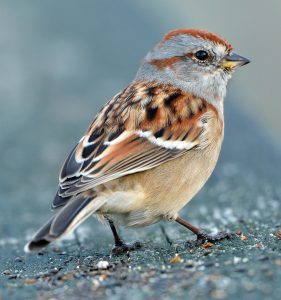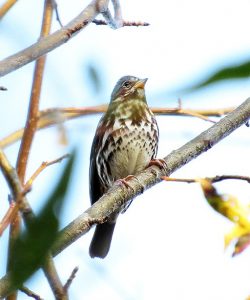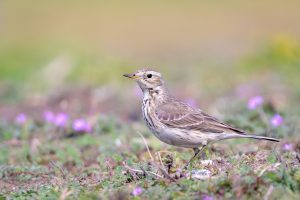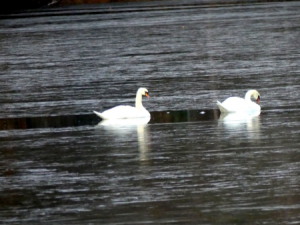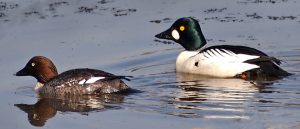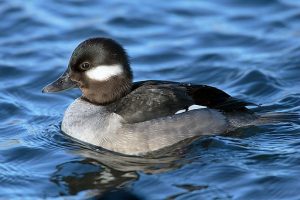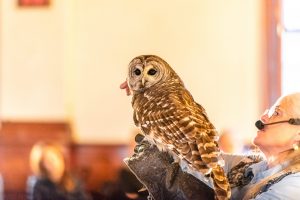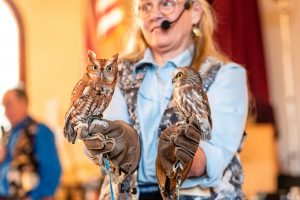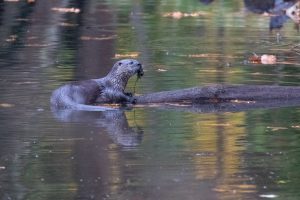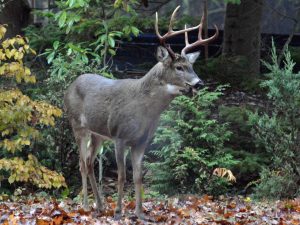Written by Gwyn Loud for the Lincoln Land Conservation Trust. She welcomes your sightings, questions, and photos at 781-259-8690 or gwynloud555 at gmail.com.
Climate change and its impact on weather has been very evident over the past month. October was unusually warm, with a strong nor’easter slamming us mid-month, downing trees and power lines. On the last day of October the temperature reached seventy but just a week later, an arctic blast sent us into a deep freeze, breaking records for the date in many places. Ponds got an unusually early skim of ice.
The landscape colors are muted now, with most deciduous trees, except oaks, devoid of leaves. At this season we can easily see old birds’ nests, and the dreys (leafy nests) built by gray squirrels high in trees for winter shelter. Speaking of leaves, instead of having leaves carted off in bags by landscapers, please consider making some leaf piles in a corner of your property. These will provide wintering spots for insects and other small wildlife, and will eventually turn into good compost for your garden.
This is a huge mast year with thousands of acorns on the ground. There are ripple effects of such a plentiful food source up and down the food chain. For example, more acorns lead to bigger populations of white-footed mice. They eat the pupae of gypsy moths, so that means fewer gypsy moths to damage trees next spring. But the mice carry the bacteria for Lyme Disease, which means more ticks. However, mice are food for animals such as owls and red foxes, so more mice means higher survival for them. To read more about these complex ecological relationships check out research by the Cary Institute for Ecosystem Studies at https://www.caryinstitute.org/news-insights/press-release/forest-ecology-shapes-lyme-disease-risk-eastern-us
Fall bird migration continued into October, and a few species such as fox sparrows are still passing through. Late migrants such as killdeer, American pipits, white-crowned sparrows, and a single hermit thrush, palm warbler, vesper sparrow, Tennessee warbler, indigo bunting, and bobolink were all spotted at Drumlin Farm since mid-October, as well as three yellow-bellied sapsuckers and both ruby-crowned and golden-crowned kinglets. An observer counted a flock of 230 double-crested cormorants headed south high overhead and a flock of eighty-five cedar waxwings was spotted. The waxwings, like a number of robins and bluebirds, will stay here all winter, feeding on berries. Birds such as great blue herons and belted kingfishers will linger in small numbers as long as ponds are open and fish are available.
Other recent avian sightings include bald eagles overhead, and ducks such as hooded mergansers on the Cambridge Reservoir, and ring-necked ducks on Valley Pond as well as the Reservoir. A couple of mute swans have remained in patches of open water on Farrar Pond and an unusual hybrid of a bufflehead and common golden-eye was spotted on Flint’s Pond. Owls, both barred and great-horned, continue to be vocal all over town. Saw-whet owls, our tiniest owl, have been banded at the Drumlin Farm banding station as usual at this season, although their numbers have been very low so far. Mark and Marcia Wilson gave a terrific program using live owls at Bemis Hall on Nov. 10. They urged us not to use rodenticides to kill mice or other rodents, as the sick animals will find their way outdoors and may be eaten by predators such as owls, sending poison up the food chain, resulting death for both predator and prey. The Wilsons suggest old-fashioned snap traps as the best and most humane way to catch mice in the house (unless you have an indoor cat, as I do!).
Winter arrivals from the north at our feeders include white-throated and dark-eyed juncos and I’m still waiting for one of my favorites, the American tree sparrow. Naturalist Tia Pinney, listening to white-throated sparrows in Boyce Field wrote, “Lots of weak, aborted phrasing songs… I’m always fascinated how they seem so tentative at the beginning of the season, like they’re not sure they’ve got the right language or pronunciation.”
Coyotes have been howling a lot, sometimes in groups of at least five calling back and forth across fields, as reported from the Flint Farm. A fisher was seen by Weston Road, near the Weston line. As naturalist Mary Holland writes in her blog, “Fishers have been actively trapped since the 1700’s and because trapping was largely unregulated, fishers were extirpated in much of the Northeast in the 1930’s. Restrictions on trapping, the regrowth of forests and the re-introduction of fishers in locations where porcupines were thriving all contributed to the comeback of the fisher. Today they populate most of New England.” Other mammals reported include several bucks, two river otters on ponds at Drumlin Farm and a bobcat near conservation land off Morningside Lane.
The warmth in October meant that insects such as crickets and katydids were still singing. We also heard a few frogs calling such as a spring peeper, wood frog, and gray tree frog, even into November. On a warm rainy night a walker found a spotted salamander crossing the road. At The Flint Farm snapping turtle babies were seen well into October and over sixty hatchlings emerged in the riding ring in September. How do turtles and frogs spend the winter? Aquatic frogs such as bullfrogs, leopard frogs and green frogs spend the coldest months lying on the mud at the bottom of ponds, though may swim a bit during warm spells. They can absorb oxygen from the water. Wood frogs, spring peepers, and gray tree frogs, on the other hand, take shelter under leaf litter, in small burrows, or under rocks and logs. They can withstand temperatures well below zero F due to “antifreeze” (glycerol) in their blood, allowing them to freeze and thaw as the weather changes. Snapping and painted turtles bury in the mud at the bottom of ponds, although painted turtles have been seen basking during winter thaws or swimming beneath the ice.
Ending with a warning about ticks, comes a message from the UMass Extension Service: “Not everyone knows that the adult ticks have a second peak season in the fall. Here in New England, adult deer ticks re-emerged in force for the fall season right around October 15th and will be active for at least another month, or until the ground is covered in snow. Be sure to check yourself and your two- to four-footed family members for ticks every day.”
© Gwyn Loud


